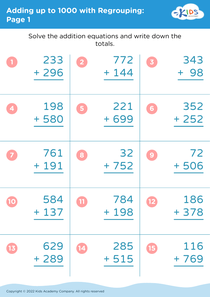Shape Recognition Adding up to 1000 Without Regrouping Worksheets for Ages 4-7
3 filtered results
-
From - To
Welcome to our "Shape Recognition Adding Up to 1000 Without Regrouping Worksheets," specially designed for children aged 4-7. These engaging worksheets combine foundational math skills with fun shape recognition activities, helping young learners build confidence in numbers and geometry. Each worksheet provides opportunities for children to practice addition up to 1000 without regrouping, reinforcing their understanding of quantities while enhancing their ability to identify and differentiate between various shapes. Our carefully crafted exercises make learning enjoyable, ensuring kids stay motivated. Perfect for home or classroom use, these resources lay the groundwork for lifelong mathematical success. Excite your child's learning today!
Shape recognition and basic arithmetic skills, such as adding up to 1000 without regrouping, are fundamental components of early childhood education that parents and teachers should prioritize for children aged 4-7. First, shape recognition is crucial for cognitive development as it helps children understand spatial relationships, enhances their problem-solving abilities, and builds a foundation for geometry. Recognizing different shapes is not only essential for math but also is integrated into art, science, and everyday life.
Adding up to 1000 without regrouping fosters numerical fluency, allowing children to develop a strong understanding of place values and mental math strategies. This skill encourages confidence in math, reducing anxiety associated with more complex calculations later. Mastery of these skills prepares students for future academic success, as math concepts build upon one another.
Additionally, engaging in activities that incorporate shape recognition and addition can also promote critical thinking, creativity, and collaboration among young learners. By investing in these foundational skills, parents and teachers empower children to become capable mathematicians and confident problem-solvers. Overall, prioritizing these learning objectives nurtures a love for learning and paves the way for future educational achievements.

















